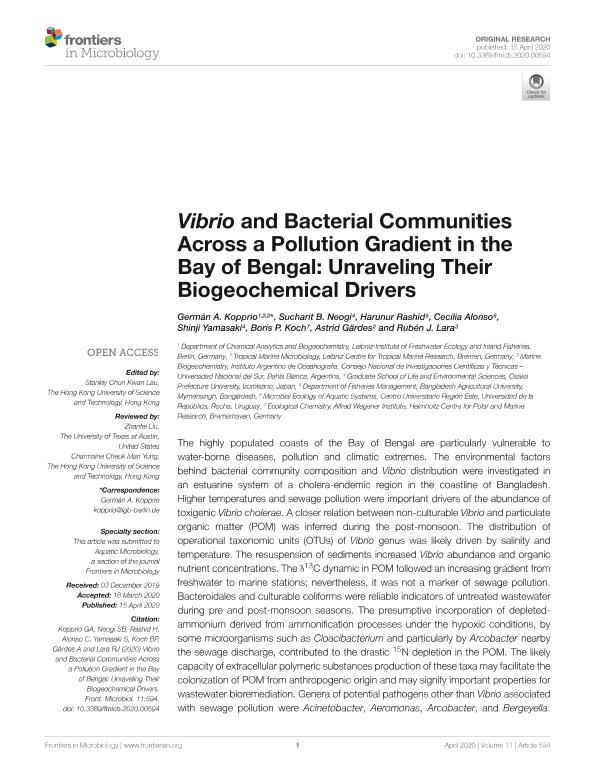Mostrar el registro sencillo del ítem
dc.contributor.author
Kopprio, Germán Adolfo

dc.contributor.author
Neogi, Sucharit Basu

dc.contributor.author
Rashid, Harunur
dc.contributor.author
Alonso, Cecilia

dc.contributor.author
Yamasaki, Shinji
dc.contributor.author
Koch, Boris Peter

dc.contributor.author
Gärdes, Astrid
dc.contributor.author
Lara, Ruben Jose

dc.date.available
2021-09-01T03:58:10Z
dc.date.issued
2020-04-15
dc.identifier.citation
Kopprio, Germán Adolfo; Neogi, Sucharit Basu; Rashid, Harunur; Alonso, Cecilia; Yamasaki, Shinji; et al.; Vibrio and Bacterial Communities Across a Pollution Gradient in the Bay of Bengal: Unraveling Their Biogeochemical Drivers; Frontiers Media S.A.; Frontiers in Microbiology; 11; 15-4-2020; 1-16
dc.identifier.issn
1664-302X
dc.identifier.uri
http://hdl.handle.net/11336/139395
dc.description.abstract
The highly populated coasts of the Bay of Bengal are particularly vulnerable to water-borne diseases, pollution and climatic extremes. The environmental factors behind bacterial community composition and Vibrio distribution were investigated in an estuarine system of a cholera-endemic region in the coastline of Bangladesh. Higher temperatures and sewage pollution were important drivers of the abundance of toxigenic Vibrio cholerae. A closer relation between non-culturable Vibrio and particulate organic matter (POM) was inferred during the post-monsoon. The distribution of operational taxonomic units (OTUs) of Vibrio genus was likely driven by salinity and temperature. The resuspension of sediments increased Vibrio abundance and organic nutrient concentrations. The δ13C dynamic in POM followed an increasing gradient from freshwater to marine stations; nevertheless, it was not a marker of sewage pollution. Bacteroidales and culturable coliforms were reliable indicators of untreated wastewater during pre and post-monsoon seasons. The presumptive incorporation of depleted-ammonium derived from ammonification processes under the hypoxic conditions, by some microorganisms such as Cloacibacterium and particularly by Arcobacter nearby the sewage discharge, contributed to the drastic 15N depletion in the POM. The likely capacity of extracellular polymeric substances production of these taxa may facilitate the colonization of POM from anthropogenic origin and may signify important properties for wastewater bioremediation. Genera of potential pathogens other than Vibrio associated with sewage pollution were Acinetobacter, Aeromonas, Arcobacter, and Bergeyella. The changing environmental conditions of the estuary favored the abundance of early colonizers and the island biogeography theory explained the distribution of some bacterial groups. This multidisciplinary study evidenced clearly the eutrophic conditions of the Karnaphuli estuary and assessed comprehensively its current bacterial baseline and potential risks. The prevailing conditions together with human overpopulation and frequent natural disasters, transform the region in one of the most vulnerable to climate change. Adaptive management strategies are urgently needed to enhance ecosystem health.
dc.format
application/pdf
dc.language.iso
eng
dc.publisher
Frontiers Media S.A.

dc.rights
info:eu-repo/semantics/openAccess
dc.rights.uri
https://creativecommons.org/licenses/by/2.5/ar/
dc.subject
15N DEPLETION
dc.subject
16S RRNA DIVERSITY
dc.subject
ARCOBACTER
dc.subject
CLOACIBACTERIUM
dc.subject
ISOTOPES
dc.subject
ORGANIC MATTER
dc.subject
SEWAGE
dc.subject
VIBRIO CHOLERAE
dc.subject.classification
Oceanografía, Hidrología, Recursos Hídricos

dc.subject.classification
Ciencias de la Tierra y relacionadas con el Medio Ambiente

dc.subject.classification
CIENCIAS NATURALES Y EXACTAS

dc.title
Vibrio and Bacterial Communities Across a Pollution Gradient in the Bay of Bengal: Unraveling Their Biogeochemical Drivers
dc.type
info:eu-repo/semantics/article
dc.type
info:ar-repo/semantics/artículo
dc.type
info:eu-repo/semantics/publishedVersion
dc.date.updated
2021-08-19T20:01:22Z
dc.journal.volume
11
dc.journal.pagination
1-16
dc.journal.pais
Suiza

dc.journal.ciudad
Lausana
dc.description.fil
Fil: Kopprio, Germán Adolfo. Consejo Nacional de Investigaciones Científicas y Técnicas. Centro Científico Tecnológico Conicet - Bahía Blanca. Instituto Argentino de Oceanografía. Universidad Nacional del Sur. Instituto Argentino de Oceanografía; Argentina. Leibniz - Institute of Freshwater Ecology and Inland Fisheries; Alemania. Leibniz Center For Tropical Marine Research ; Alemania
dc.description.fil
Fil: Neogi, Sucharit Basu. Osaka Prefecture University; Japón
dc.description.fil
Fil: Rashid, Harunur. Bangladesh Agricultural University; Bangladesh
dc.description.fil
Fil: Alonso, Cecilia. Universidad de la República. Centro Universitario Regional del Este; Uruguay
dc.description.fil
Fil: Yamasaki, Shinji. Osaka Prefecture University; Japón
dc.description.fil
Fil: Koch, Boris Peter. Alfred-Wegener-Institut. Helmholtz-Zentrum für Polar und Meeresforschung; Alemania
dc.description.fil
Fil: Gärdes, Astrid. Leibniz Center For Tropical Marine Research; Alemania
dc.description.fil
Fil: Lara, Ruben Jose. Consejo Nacional de Investigaciones Científicas y Técnicas. Centro Científico Tecnológico Conicet - Bahía Blanca. Instituto Argentino de Oceanografía. Universidad Nacional del Sur. Instituto Argentino de Oceanografía; Argentina
dc.journal.title
Frontiers in Microbiology
dc.relation.alternativeid
info:eu-repo/semantics/altIdentifier/url/https://www.frontiersin.org/article/10.3389/fmicb.2020.00594/full
dc.relation.alternativeid
info:eu-repo/semantics/altIdentifier/doi/http://dx.doi.org/10.3389/fmicb.2020.00594
Archivos asociados
